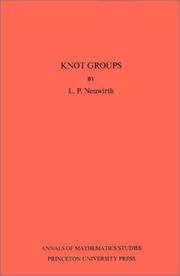| Listing 1 - 2 of 2 |
Sort by
|

ISBN: 0691079919 1400882036 9780691079912 Year: 1965 Volume: 56 Publisher: Princeton, N. J.
Abstract | Keywords | Export | Availability | Bookmark
 Loading...
Loading...Choose an application
- Reference Manager
- EndNote
- RefWorks (Direct export to RefWorks)
The description for this book, Knot Groups. Annals of Mathematics Studies. (AM-56), Volume 56, will be forthcoming.
Topology --- 512 --- Algebra --- 512 Algebra --- Knot theory. --- Knots (Topology) --- Low-dimensional topology --- Abelian group. --- Alexander duality. --- Alexander polynomial. --- Algebraic theory. --- Algorithm. --- Analytic continuation. --- Associative property. --- Automorphism. --- Axiom. --- Bijection. --- Binary relation. --- Calculation. --- Central series. --- Characterization (mathematics). --- Cobordism. --- Coefficient. --- Cohomology. --- Combinatorics. --- Commutator subgroup. --- Complete theory. --- Computation. --- Conjugacy class. --- Conjugate element (field theory). --- Connected space. --- Connectedness. --- Coprime integers. --- Coset. --- Covering space. --- Curve. --- Cyclic group. --- Dehn's lemma. --- Determinant. --- Diagonalization. --- Diagram (category theory). --- Dimension. --- Direct product. --- Equivalence class. --- Equivalence relation. --- Euclidean space. --- Euler characteristic. --- Existential quantification. --- Fiber bundle. --- Finite group. --- Finitely generated module. --- Frattini subgroup. --- Free abelian group. --- Fundamental group. --- Geometry. --- Group ring. --- Group theory. --- Group with operators. --- Hausdorff space. --- Homeomorphism. --- Homology (mathematics). --- Homomorphism. --- Homotopy group. --- Homotopy. --- Identity matrix. --- Inner automorphism. --- Interior (topology). --- Intersection number (graph theory). --- Knot group. --- Linear combination. --- Manifold. --- Mathematical induction. --- Monomorphism. --- Morphism. --- Morse theory. --- Natural transformation. --- Non-abelian group. --- Normal subgroup. --- Orientability. --- Permutation. --- Polynomial. --- Presentation of a group. --- Principal ideal domain. --- Principal ideal. --- Root of unity. --- Semigroup. --- Simplicial complex. --- Simply connected space. --- Special case. --- Square matrix. --- Subgroup. --- Subset. --- Summation. --- Theorem. --- Three-dimensional space (mathematics). --- Topological space. --- Topology. --- Torus knot. --- Transfinite number. --- Trefoil knot. --- Trichotomy (mathematics). --- Trivial group. --- Triviality (mathematics). --- Two-dimensional space. --- Unit vector. --- Wreath product.
Book
ISBN: 1400826950 Year: 2005 Publisher: Princeton, NJ : Princeton University Press,
Abstract | Keywords | Export | Availability | Bookmark
 Loading...
Loading...Choose an application
- Reference Manager
- EndNote
- RefWorks (Direct export to RefWorks)
It is now some thirty years since Deligne first proved his general equidistribution theorem, thus establishing the fundamental result governing the statistical properties of suitably "pure" algebro-geometric families of character sums over finite fields (and of their associated L-functions). Roughly speaking, Deligne showed that any such family obeys a "generalized Sato-Tate law," and that figuring out which generalized Sato-Tate law applies to a given family amounts essentially to computing a certain complex semisimple (not necessarily connected) algebraic group, the "geometric monodromy group" attached to that family. Up to now, nearly all techniques for determining geometric monodromy groups have relied, at least in part, on local information. In Moments, Monodromy, and Perversity, Nicholas Katz develops new techniques, which are resolutely global in nature. They are based on two vital ingredients, neither of which existed at the time of Deligne's original work on the subject. The first is the theory of perverse sheaves, pioneered by Goresky and MacPherson in the topological setting and then brilliantly transposed to algebraic geometry by Beilinson, Bernstein, Deligne, and Gabber. The second is Larsen's Alternative, which very nearly characterizes classical groups by their fourth moments. These new techniques, which are of great interest in their own right, are first developed and then used to calculate the geometric monodromy groups attached to some quite specific universal families of (L-functions attached to) character sums over finite fields.
Monodromy groups. --- Sheaf theory. --- L-functions. --- Addition. --- Additive group. --- Affine space. --- Algebraic group. --- Algebraic integer. --- Algebraically closed field. --- Automorphism. --- Base change. --- Big O notation. --- Central moment. --- Change of base. --- Character sum. --- Classical group. --- Codimension. --- Computation. --- Conjecture. --- Conjugacy class. --- Constant function. --- Convolution. --- Corollary. --- Critical value. --- Dense set. --- Determinant. --- Dimension (vector space). --- Dimension. --- Diophantine equation. --- Direct sum. --- Discrete group. --- Disjoint sets. --- Divisor (algebraic geometry). --- Divisor. --- Eigenvalues and eigenvectors. --- Elliptic curve. --- Empty set. --- Equidistribution theorem. --- Existential quantification. --- Exponential sum. --- Faithful representation. --- Finite field. --- Finite group. --- Fourier transform. --- Function field. --- Function space. --- Generic point. --- Group theory. --- Hypersurface. --- Inequality (mathematics). --- Integer. --- Irreducible representation. --- Isomorphism class. --- L-function. --- Leray spectral sequence. --- Linear space (geometry). --- Linear subspace. --- Moment (mathematics). --- Monodromy. --- Morphism. --- Natural number. --- Normal subgroup. --- Orthogonal group. --- P-value. --- Parameter space. --- Parameter. --- Parity (mathematics). --- Partition of a set. --- Perverse sheaf. --- Polynomial. --- Power series. --- Prime number. --- Probability space. --- Probability theory. --- Proper morphism. --- Pullback (category theory). --- Random variable. --- Reductive group. --- Relative dimension. --- Root of unity. --- Scalar multiplication. --- Scientific notation. --- Set (mathematics). --- Sheaf (mathematics). --- Special case. --- Subgroup. --- Subobject. --- Subset. --- Summation. --- Surjective function. --- Symmetric group. --- Symplectic group. --- Tensor product. --- Theorem. --- Theory. --- Topology. --- Trace (linear algebra). --- Trivial group. --- Unipotent. --- Variable (mathematics). --- Variance. --- Vector space. --- Zariski topology.
| Listing 1 - 2 of 2 |
Sort by
|

 Search
Search Feedback
Feedback About UniCat
About UniCat  Help
Help News
News